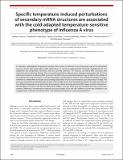| dc.contributor.author | Chursov, Andrey | |
| dc.contributor.author | Kopetzky, Sebastian J. | |
| dc.contributor.author | Leshchiner, Ignaty | |
| dc.contributor.author | Kondofersky, Ivan | |
| dc.contributor.author | Theis, Fabian J. | |
| dc.contributor.author | Frishman, Dmitrij | |
| dc.contributor.author | Shneider, Alexander | |
| dc.date.accessioned | 2013-05-08T15:42:10Z | |
| dc.date.issued | 2012 | |
| dc.identifier.citation | Chursov, Andrey, Sebastian J. Kopetzky, Ignaty Leshchiner, Ivan Kondofersky, Fabian J. Theis, Dmitrij Frishman, and Alexander Shneider. 2012. Specific temperature-induced perturbations of secondary mrna structures are associated with the cold-adapted temperature-sensitive phenotype of influenza a virus. RNA Biology 9(10): 1266-1274. | en_US |
| dc.identifier.issn | 1547-6286 | en_US |
| dc.identifier.uri | http://nrs.harvard.edu/urn-3:HUL.InstRepos:10612578 | |
| dc.description.abstract | For decades, cold-adapted, temperature-sensitive (ca/ts) strains of influenza A virus have been used as live attenuated vaccines. Due to their great public health importance it is crucial to understand the molecular mechanism(s) of cold adaptation and temperature sensitivity that are currently unknown. For instance, secondary RNA structures play important roles in influenza biology. Thus, we hypothesized that a relatively minor change in temperature (32–39°C) can lead to perturbations in influenza RNA structures and, that these structural perturbations may be different for mRNAs of the wild type (wt) and ca/ts strains. To test this hypothesis, we developed a novel in silico method that enables assessing whether two related RNA molecules would undergo (dis)similar structural perturbations upon temperature change. The proposed method allows identifying those areas within an RNA chain where dissimilarities of RNA secondary structures at two different temperatures are particularly pronounced, without knowing particular RNA shapes at either temperature. We identified such areas in the NS2, PA, PB2 and NP mRNAs. However, these areas are not identical for the wt and ca/ts mutants. Differences in temperature-induced structural changes of wt and ca/ts mRNA structures may constitute a yet unappreciated molecular mechanism of the cold adaptation/temperature sensitivity phenomena. | en_US |
| dc.language.iso | en_US | en_US |
| dc.publisher | Landes Bioscience | en_US |
| dc.relation.isversionof | doi:10.4161/rna.22081 | en_US |
| dc.relation.hasversion | http://www.ncbi.nlm.nih.gov/pmc/articles/PMC3583857/pdf/ | en_US |
| dash.license | LAA | |
| dc.subject | influenza | en_US |
| dc.subject | RNA | en_US |
| dc.subject | structure | en_US |
| dc.subject | temperature | en_US |
| dc.subject | vaccine | en_US |
| dc.title | Specific temperature-induced perturbations of secondary mRNA structures are associated with the cold-adapted temperature-sensitive phenotype of influenza A virus | en_US |
| dc.type | Journal Article | en_US |
| dc.description.version | Version of Record | en_US |
| dc.relation.journal | RNA Biology | en_US |
| dash.depositing.author | Leshchiner, Ignaty | |
| dc.date.available | 2013-05-08T15:42:10Z | |
| dc.identifier.doi | 10.4161/rna.22081 | * |
| dash.contributor.affiliated | Leshchiner, Ignaty | |


